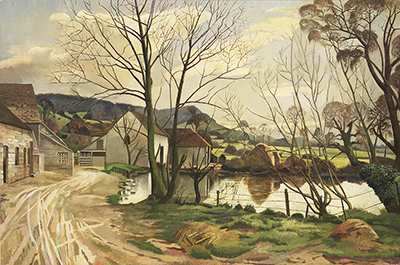Farm Pond, Leonard Stanley, created in 1940, is an oil-on-canvas painting by Stanley Spencer that depicts an agricultural scene. Spencer, in the early years of World War II, painted a number of outdoors scenes and spent some time at the village of Leonard Stanley in Gloucestershire.
The English artist, while staying at the White Hart Inn with some artistic friends, executed a painting of a local farm from the perspective of a dirt road. The landscape painting, measuring 610 millimetres by 914 millimetres, is on display at the Tate Britain art gallery and is on loan from the Hong Kong Museum of Art. A pond, the focal point of the painting, is situated on the right-hand side of the canvas and nearby trees as well as a white building are reflected in its calm waters. The dirt road, indented with wheel tracks, winds between the white buildings on the right-hand side of the painting and a building that is constructed from either breeze-block or worked stone. Tree-topped hills are visible in the distance, providing a natural backdrop to the artificial buildings and road, while the blue sky is visible behind white clouds that are tinged towards the left-hand side of the canvas with grey smudges.
It is believed, due to an examination of the painting under ultraviolet light, that Spencer reworked the painting at a later date and that the original white pigment used to create the clouds was lead-based while the white pigment used in the later retouching of the artwork was zinc-based. Traces of white can also be seen in the ruts and furrows made by the agricultural vehicles, like muddy indentations catching the light, and in the pond. The still, mirror-like surface of the pond is silver and appears to be a reflection of the blue sky while there are notes of green and brown beneath the metallic patina.
Landscape paintings of idyllic rural scenes, such as the painting of the farm pond in Leonard Stanley, reflects the atmosphere of the early phases of World War II where there was little fighting compared to the later stages of the conflict. This period of relative inactivity, known as the Phoney War, provided Spencer with an opportunity to create outdoors paintings of non-military subjects that would be denied to him after the Second World War began to intensify. The end of the Phoney War, occurring in the May of 1940, marked a turning point in the English artist's career and he became an official war artist.




